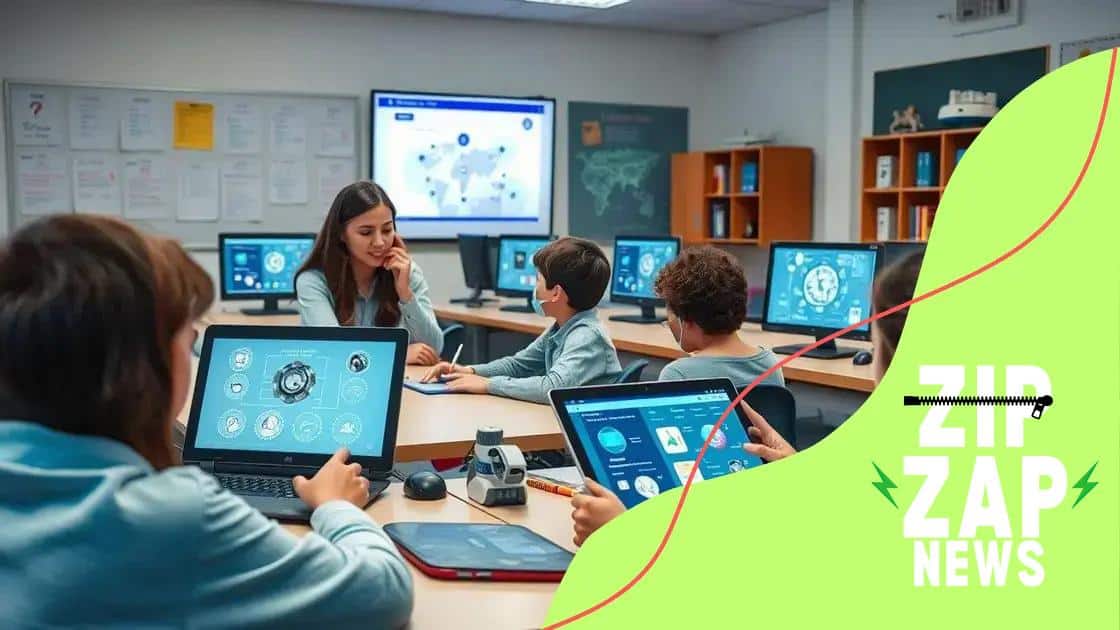AI tools for assisting special education needs

AI tools for assisting special education needs enhance personalized learning by providing customized educational experiences, addressing diverse student challenges, and enabling educators to adapt their teaching strategies effectively.
AI tools for assisting special education needs are changing how we approach learning for students who require additional support. Have you ever wondered how technology can make education more inclusive? Let’s dive in.
Understanding special education needs
Understanding special education needs is essential for creating an inclusive learning environment. This concept encompasses the diverse requirements of students who may struggle in traditional classroom settings due to various challenges, including learning disabilities, emotional difficulties, or physical impairments.
Special education needs vary widely among individuals, making it crucial to recognize and understand these differences. By focusing on tailored teaching methods, educators can better meet the unique needs of their students.
Types of special education needs
There are several common types of special education needs that educators should be aware of:
- Learning disabilities: These affect a child’s ability to read, write, and perform math calculations.
- Attention Deficit Hyperactivity Disorder (ADHD): This condition impacts a student’s focus and behavior.
- Autism Spectrum Disorder: This affects communication and social interaction, requiring specialized approaches.
- Emotional and behavioral disorders: These can hinder a student’s ability to function in a classroom setting.
Recognizing these needs helps educators implement effective strategies. Understanding the individual learning styles and requirements of each student leads to better educational outcomes. Teachers can adapt their lesson plans and teaching methods to ensure all students can engage with the curriculum.
Importance of individualized support
Individualized support is crucial for students with special education needs. By providing tailored learning experiences, teachers can foster a sense of belonging and improve the overall educational experience.
Utilizing tools and resources specifically designed for special education can make a significant difference. For example, assistive technology can enhance learning opportunities for students with disabilities. This includes software programs, communication devices, and adaptive tools that facilitate learning.
In summary, understanding special education needs is fundamental for teachers and educators. By embracing individualized support and utilizing appropriate resources, we can create an educational environment that promotes success and inclusivity for all learners.
The role of AI in tailored learning
The role of AI in tailored learning is becoming increasingly vital in education. With the diverse needs of students, artificial intelligence (AI) provides flexible solutions that adapt to individual learning styles and paces.
AI can analyze how a student learns best, using data to create personalized educational plans. This means that students receive the support they need to thrive. Each learning journey is unique, and technology can identify strengths and weaknesses.
Benefits of AI in education
Implementing AI into classrooms offers numerous advantages:
- Personalized learning: AI tailors lessons to suit each student, enhancing their engagement.
- Real-time feedback: Educators and students receive immediate insights into progress and areas needing improvement.
- Resource efficiency: AI can automate tasks, allowing teachers to focus on instruction rather than paperwork.
- Accessible learning: Students with disabilities can benefit from AI tools that meet their specific needs.
Utilizing AI for tailored learning fosters a supportive educational experience. By integrating these technologies, educators can ensure no student is left behind.
How AI supports teachers
AI not only benefits students but also supports teachers in their roles. With the help of AI tools, teachers can identify students who may need extra attention.
This technology allows educators to create lesson plans that resonate with their classes more easily. Through predictive analytics, they can foresee potential challenges and adjust their teaching strategies accordingly. Collaboration between teachers and AI leads to enhanced classroom dynamics.
Incorporating AI into education transforms traditional approaches. As technology continues to develop, its impact on tailored learning will grow, making personalized education accessible for all.
Top AI tools for educators

Top AI tools for educators are transforming the teaching landscape. These innovative tools provide support and resources to enhance learning experiences for both educators and students. By integrating AI into the classroom, teachers can streamline their tasks and improve student engagement.
Many AI tools offer customizable features that cater to individual learning needs. Educators can select from various programs to find ones that align with their teaching styles. This flexibility makes it easier to create an inclusive environment.
Popular AI tools
Here are some of the most effective AI tools for educators:
- Google Classroom: An all-in-one platform for managing classroom assignments and communications.
- Kahoot: A game-based learning platform that increases student participation through interactive quizzes.
- Duolingo: An AI-driven language learning app that personalizes lessons for each user’s pace.
- Classcraft: A platform that gamifies classroom learning, encouraging student engagement through role-playing.
These tools empower teachers to enhance their lessons and make learning more enjoyable. They also save time, allowing educators to focus on fostering relationships with their students.
How to choose the right AI tools
Choosing the right AI tools is essential for enhancing the educational experience. Educators should consider factors such as user-friendliness, compatibility with existing platforms, and the specific needs of their students.
Trial versions often allow teachers to test tools before committing. This can provide valuable insight into how the tool works in a real classroom setting. Additionally, seeking recommendations from other educators can guide the decision-making process.
Integrating AI tools into education is an ongoing journey. By selecting the right tools, teachers can create a more dynamic and supportive learning environment. Their efforts can lead to improved academic outcomes and increased student satisfaction.
Benefits for students with diverse needs
Benefits for students with diverse needs in educational settings are significant, particularly when integrating AI tools. These tools help address the unique challenges faced by students who may learn differently.
AI applications create personalized learning paths, enabling students to progress at their own pace. With tailored content that matches their individual skills and interests, students can stay engaged and motivated in their learning journeys.
Key advantages of AI for diverse learners
Some of the most notable benefits for students with diverse needs include:
- Customized learning experiences: AI tools adapt lessons to suit individual learning styles. This ensures that every student is engaged and can understand the material better.
- Increased accessibility: Features like speech-to-text or text-to-speech can help students with disabilities access content more easily.
- Real-time feedback: Immediate insights allow students to identify areas where they need improvement, helping them stay on track.
- Enhanced motivation: Gamification and interactive elements in learning materials make education more enjoyable, especially for students who might struggle with traditional methods.
Moreover, AI can assist educators in identifying students who may need additional support. By analyzing performance data, teachers can quickly determine which students may benefit from different instructional strategies.
Collaborative learning opportunities
AI tools also foster collaborative learning among students. With platforms that encourage group work and peer interactions, students can share their unique perspectives and help each other learn.
This collaborative environment promotes inclusivity and strengthens social skills, which are essential for overall development. Students learn not only from the content but also from one another, benefiting from shared experiences.
In summary, the integration of AI tools provides numerous benefits for students with diverse needs. These advancements not only enhance the learning experience but also help educators create a more inclusive and supportive classroom atmosphere.
Overcoming challenges with AI technology
Overcoming challenges with AI technology is essential for enhancing educational outcomes, particularly for students with diverse needs. While integrating AI into the classroom comes with its own set of challenges, the benefits often outweigh these hurdles.
One major challenge is the initial resistance to change. Many educators may be apprehensive about adopting new technologies. However, providing proper training can help teachers become comfortable with AI tools, making the transition smoother.
Addressing common challenges
Several common obstacles educators encounter when implementing AI include:
- Lack of resources: Schools may need access to better technology or training to utilize AI effectively.
- Understanding the technology: Teachers must grasp how to implement AI tools meaningfully to enhance their teaching.
- Data privacy concerns: Safeguarding student information is crucial, and schools must ensure that their chosen AI tools comply with privacy regulations.
- Equity in access: Ensuring that all students, regardless of background, can access AI technologies is essential for equitable education.
Overcoming these challenges requires collaboration among educators, administrators, and technology providers. By working together, schools can make informed decisions about which tools best meet their needs.
The role of professional development
Professional development plays a significant role in helping educators adapt to AI technology. Training programs can showcase how AI can improve teaching strategies and student engagement. Workshops that emphasize hands-on experiences allow teachers to learn by doing.
Furthermore, establishing a supportive community within schools encourages sharing best practices and experiences. Educators can collaborate, troubleshoot challenges, and celebrate successes together, reinforcing a culture of continuous improvement.
AI technology is not a one-size-fits-all solution, but when implemented thoughtfully, it can transform education. By overcoming challenges collectively, educators can unlock the full potential of AI, ensuring that every student receives the support they need.
In conclusion, embracing AI technology in education offers numerous benefits for both students and educators. By recognizing and addressing the challenges that come with its implementation, we can create a more inclusive and effective learning environment. Educators play a crucial role in this journey, as their willingness to adapt and learn new tools helps to unlock the full potential of AI. Through collaboration, professional development, and supportive communities, we can overcome obstacles and ensure that every student receives the personalized support they deserve. Ultimately, AI has the power to transform education and make learning accessible and engaging for all students, regardless of their needs.
FAQ – Questions about AI Tools in Education
How can AI technology support students with diverse needs?
AI technology can provide personalized learning experiences, helping students progress at their own pace and adapting content to their individual needs.
What challenges do educators face when integrating AI tools?
Common challenges include resistance to change, the need for proper training, data privacy concerns, and ensuring equitable access for all students.
What role does professional development play in using AI technology?
Professional development provides educators with the training needed to effectively implement AI tools in their teaching strategies, fostering a supportive learning environment.
What are the long-term impacts of using AI in education?
The long-term impacts include transforming teaching methods, enhancing student engagement, and creating a more inclusive and effective educational system.





